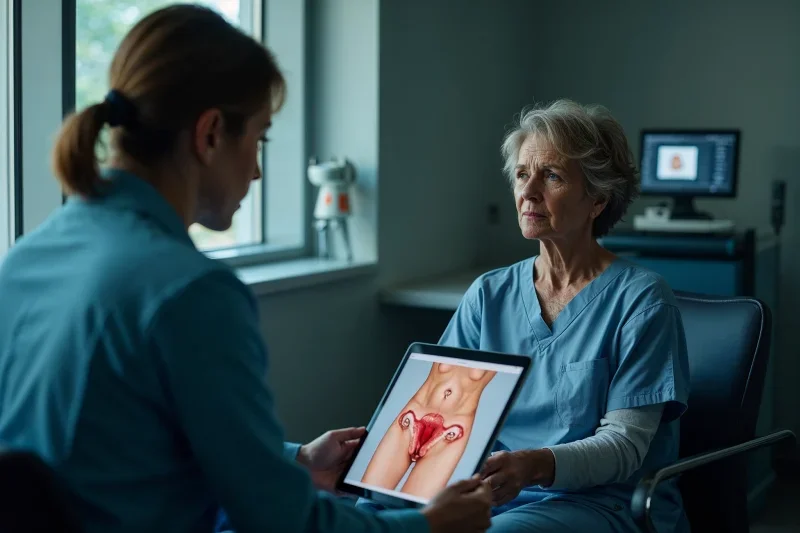The Future Is Now: Latest Technological Advancements in Robotic Essure Operations
Categories:
By: Ethan Cole
Robotic-assisted Essure removal has evolved to offer precision, safety, and reduced recovery time.
High-definition vision systems in robotics improve accuracy in detecting and removing Essure devices.
Robotic Tubouterine Anastomosis offers a less invasive reversal technique for Essure, restoring fallopian tube function.
Preoperative imaging using high-resolution CT or MRI supports successful Essure removal by providing detailed 3D internal views.
Continuous innovations in robotic-assisted surgery are shaping the future of Essure-related procedures, enhancing patient safety and experiences.
Introduction
In the current landscape of healthcare, there is a noteworthy transition towards the utilization of robotic assistance in surgical operations, particularly those involving Essure procedures. Advanced robotic technologies offer unparalleled precision, contributing to diminished trauma, expedited recovery periods, and improved patient outcomes.
Innovations in robotic tools are transforming the medical field, with features such as high-definition vision systems being employed for meticulous Essure removal and tubouterine anastomosis. These advancements facilitate safer and less invasive alternatives for birth control.
The realm of science continues to expand its boundaries, and it is crucial to remain vigilant of the upcoming breakthroughs poised to revolutionize this sector. The future is brimming with potential, with numerous remarkable technological advancements on the horizon.
Introduction to Robotic-Assisted Surgery in Reproductive Healthcare
Let's shed light on the concept of robotic-assisted surgery and its vital role in women's health. Imagine a world where robots aid in enhancing precision and minimizing invasive procedures in reproductive healthcare. Welcome to the reality of modern medicine where technology is reshaping healthcare delivery, particularly in the field of reproductive health.
Understanding Robotic-Assisted Surgery
The world of reproductive healthcare has been revolutionized by the advent of robotic-assisted surgery. As you explore deeper into understanding robotic-assisted surgery, you'll come to realize the profound impact of these robotic healthcare innovations.
In essence, robotic-assisted surgery allows doctors to perform complex procedures with more precision, flexibility, and control than conventional techniques. It's an amalgamation of modern technology and surgical expertise, bringing about a revolutionary change in the field.
One prime example is robotic essure removal, an intricate procedure made less invasive, and potentially more successful, through the use of robotics. This guarantees less physical trauma and faster recovery for patients, a demonstration of the power of these advancements.
In the hands of skilled surgeons, these robotic tools act as an extension of their capabilities, allowing for a level of detail and control previously unattainable. This has not only resulted in improved patient outcomes but also in a shift in the way surgeries are approached and conducted.
The Role of Robotics in Women's Health
How has the rise of robotics transformed women's health? You wouldn't be off the mark if you say it's been revolutionary. Robotic-assisted essure surgery, a perfect exemplar of advanced robotic reproductive surgery, has redefined the landscape of women's reproductive health.
This surgical procedure offers women a minimally invasive solution to permanent birth control. Now, you can bid goodbye to traditional, invasive surgeries and welcome this new era of medical innovation. It's not just about the advancement in technology; it's about empowering you with safer choices and better control over your health.
Robotic gynecological advancements have also made significant strides in the diagnosis and treatment of various women's health issues. With precision and accuracy, these advancements are reducing surgical complications and post-surgery recovery time. You can now look forward to less pain, minimal scarring, and faster return to your daily routine.
In essence, the role of robotics in women's health goes beyond just surgical assistance. It's about providing you with the best care possible, reducing the physical and emotional burden of surgery, and ultimately improving your quality of life. The future of women's health is here, and it's robotic.
Overview of Essure and Its Complications
You may wonder, "What is the Essure device?" It's a form of birth control that, while usually effective, can carry significant complications. Now, let's explore these common complications and how they impact patients' lives.
What is the Essure Device?
Since its introduction in the early 2000s, Essure, a type of permanent birth control, has been a topic of much debate. Now, you may be asking, "What is the Essure device?" It's a small, flexible coil made from a nickel-titanium alloy. This device is non-surgically inserted into each of your fallopian tubes to prevent pregnancy. Over time, tissue grows around the coils, blocking the tubes and preventing fertilization.
However, the Essure device isn't without complications. Some users have reported severe pain, heavy bleeding, and unexpected pregnancies. In some cases, the device has even migrated from its original position, puncturing the fallopian tubes or uterus. These complications have led some women to seek Essure device removal options, which range from non-surgical procedures to complete hysterectomy.
Understanding the complexities of the Essure device is essential to making an informed decision about your reproductive health. Future advancements in robotic operations may offer safer, more effective solutions. As you consider your options, remember that knowledge is power and your health is in your hands.
Common Complications Associated with Essure
Numerous women have experienced complications after having the Essure device implanted. As someone who has undergone this procedure, it's important for you to be aware of these common complications associated with Essure.
You might experience chronic pain, which is one of the most reported complications. This can occur in the lower abdomen and pelvic area and may persist for a considerable period, affecting your quality of life. Allergic reactions to the device's materials, including nickel, are also common.
Irregular menstruation and heavy bleeding have been reported by many women post-procedure. In some cases, the device itself may migrate, leading to perforation of the uterus or fallopian tubes.
If you're facing these issues, an Essure reversal procedure could be an option. This minimally invasive Essure surgery involves removing the device, allowing for potential relief from these complications. However, it's not without risks and should be considered carefully.
Advancements in Robotic-Assisted Essure Removal and Reversal
Now, let's shift our focus to the advancements in robotic-assisted Essure removal and reversal. You'll see why the migration to robotic techniques is a game-changer. We'll also touch on the key innovations that are making these procedures safer and more efficient.
The Shift to Robotic Techniques: Why It Matters
In the domain of medical advancements, the change to robotic techniques truly matters, particularly in the case of Essure removal and reversal. This alteration brings to the table newfound precision, enhanced safety, and minimized recovery time – benefits of robotic surgery for Essure that are hard to overlook.
Consider the technique of robotic tubouterine anastomosis. This minimally invasive procedure allows for the reconnection of tubal segments, offering a solution to those seeking Essure reversal. The precision robotic-assisted surgeries provide is unparalleled, allowing surgeons to navigate complex anatomical structures with greater ease and confidence.
Robotic techniques have also revolutionized Essure removal. The high-definition vision system and wristed instruments of robotic platforms increase the accuracy of the procedure, reducing the risk of complications.
In essence, the change to robotic techniques in Essure operations has opened up a new world of possibilities, offering a safer and more effective approach to treatment. The benefits are clear, and as technology continues to advance, you can expect to see these procedures become the gold standard in the field.
Key Innovations in Robotic-Assisted Procedures
Why does the role of innovation hold such weight in the world of robotic-assisted medical procedures? It's simple. Advancements boost precision, minimize risk, and enhance patient recovery. Consider robotic fertility restoration surgery, a key innovation that's revolutionizing the field of gynecology.
This cutting-edge gynecological surgery employs robotic assistance to remove Essure devices, an often complex and delicate procedure. Previously, removal could result in significant tissue damage, negatively impacting fertility. Now, with pinpoint robotic precision, the risk of tissue damage is drastically reduced, thereby increasing the chances of successful fertility restoration.
Furthermore, robotic assistance has led to remarkable improvements in essure surgery patient recovery. Thanks to minimally invasive techniques, you can expect shorter hospital stays, less post-op pain, and quicker return to normal activity.
Call now to schedule an appointment with Dr. Jason Neef and explore your fertility options.
Step-by-Step Process of Robotic-Assisted Essure Removal
You'll first want to understand the role of preoperative imaging and diagnostics in the robotic-assisted Essure removal process. Then, we'll explore how the surgical procedure uses robotic technology to enhance precision. Finally, we'll discuss the importance of ensuring complete device removal to avoid fragmentation.
Preoperative Imaging and Diagnostics
Before heading into the operating room for a robotic-assisted Essure removal, there's an important step that must be undertaken: preoperative imaging and diagnostics. This isn't simply a box to be checked; it's a critical process that guarantees the utmost safety and efficacy of the operation.
First, you'll undergo high-resolution imaging, typically via computed tomography (CT) or magnetic resonance imaging (MRI). These tests offer an intricate, 3D view of your body's internal structures, providing clinicians with invaluable data on the exact location and condition of the Essure device.
Next, there are diagnostic tests to assess your overall health status. These might include blood tests, urine analysis, or cardiac function tests, amongst others. What's the purpose? To rule out any potential complications that could interfere with the procedure or recovery.
Finally, this gathered information is utilized to establish a clear surgical plan. This plan is meticulously designed, taking into consideration each patient's unique anatomy and medical history, to optimize the robotic-assisted Essure removal.
This preoperative phase is crucial. It's not only about guaranteeing a successful operation but also about minimizing potential risks and maximizing patient safety. The future of robotic surgery is here, and it all starts with thorough preoperative imaging and diagnostics.
Surgical Procedure: How Robots Enhance Precision
Having established a thorough surgical plan with the help of preoperative imaging and diagnostics, it's time to shed light on the actual procedure - the robotic-assisted Essure removal. This process leverages advanced robotics to surgically remove the Essure device with utmost precision.
Now, you might wonder, how does the robot enhance precision? Here's how: the surgeon operates from a console, manipulating robotic arms that mimic the surgeon's movements but with a greater degree of precision. This increased precision, combined with superior visualization via 3D imaging, greatly reduces the risks associated with the manual removal of the Essure device.
Furthermore, the robotic arms' ability to rotate 360 degrees allows for improved dexterity, enabling the surgeon to access hard-to-reach areas. The small, precise movements of the robotic arms also minimize tissue damage, leading to less postoperative pain and quicker recovery times for you.
In essence, robotic-assisted Essure removal offers a safer, more controlled surgical approach. It's not just about using cutting-edge technology, but about enhancing patient outcomes and improving your overall health.
Ensuring Complete Device Removal: Avoiding Fragmentation
Let's explore the step-by-step process of robotic-assisted Essure removal to understand how this advanced technology guarantees complete device removal and prevents fragmentation. The procedure begins with the robot, under the surgeon's control, inserting a miniature camera into the uterus. You'll appreciate the camera's high-definition visuals, providing an unobstructed view of the Essure device.
Next, the robot uses precision instruments to gently grasp the Essure. The surgeon, viewing the operation in real-time, guides the robot to avoid touching sensitive tissue. This accuracy minimizes the risk of fragmentation, assuring the device remains intact during removal.
The final step involves the robot extracting the Essure device. The surgeon meticulously monitors this phase to ensure no fragments remain. The robot's delicate handling and the surgeon's keen eye make this a highly effective process.
Essure Reversal: A New Hope for Fertility Restoration
You're possibly wondering about Essure reversal and how it's providing fresh hope for restoring fertility. We'll proceed to discuss the role of Robotic Tubouterine Anastomosis in reestablishing tubal patency. Later, you'll be able to compare the success rates between robotic and traditional techniques.
Robotic Tubouterine Anastomosis: Restoring Tubal Patency
The advent of Robotic Tubouterine Anastomosis has breathed new life into the field of fertility restoration, offering a beacon of hope for those seeking to reverse Essure procedures. This cutting-edge robotic technology allows surgeons to reconstruct your fallopian tubes with exceptional precision and control, reinstating tubal patency.
You're probably wondering, what exactly is tubal patency? Simply put, it's the openness or unobstructedness of your fallopian tubes. Essure, a form of permanent birth control, works by blocking your tubes. Robotic Tubouterine Anastomosis, however, can counteract this by reconnecting the blocked sections.
What sets this robotic procedure apart is the use of high-definition, 3D imaging that enhances visualization, enabling surgeons to perform complex maneuvers with unprecedented finesse. It's less invasive, reduces recovery time, and can potentially increase your chances of becoming pregnant post-Essure.
Comparing Success Rates: Robotic vs. Traditional Techniques
Imagine stepping into a world where technological advancements in medical procedures are drastically increasing success rates for fertility restoration. This isn't a sci-fi movie, it's reality. Robotic Essure reversal has shown promising results compared to traditional techniques, skyrocketing the hopes of many women longing for a child.
You're probably asking, "What makes robotic superior?" It's all about precision and dexterity. Robotic arms mimic the movements of a surgeon's hands, but with a greater range of motion and less tremor. This results in more accurate stitching and less damage to delicate tissues.
Now, let's talk numbers. Traditional techniques have a success rate of about 40-60%. Not bad, but when you compare it to the 80-90% success rate seen with robotic procedures, there's a clear winner.
But remember, each case is unique. While robotic surgery offers higher success rates, it's crucial to discuss your individual circumstances with your doctor. They'll help you decide the best path forward, ensuring you have the best chance for a successful pregnancy.
This is the future of fertility restoration. You're not just stepping into it, you're living it.
Benefits of Robotic-Assisted Procedures for Patients
You'll find that the benefits of robotic-assisted procedures are numerous and patient-centered. Imagine undergoing surgery with minimal incisions, maximum accuracy, and reduced recovery times. Factor in the lower chances of surgical complications, and it's clear why many prefer this advanced approach.
Minimal Incisions, Maximum Accuracy
Ever thought about the wonders of modern technology? Fewer things encapsulate this marvel better than the advancements in robotic Essure operations. With the precision of a robot, the incisions made are remarkably small. Yet, their accuracy is nothing short of astounding.
Robotic assistance guarantees you're not just getting a minimally invasive procedure, but one that's executed with the utmost precision. This isn't just technology for the sake of technology. It's a tool that drastically improves patient outcomes. It's the difference between a scalpel guided by a human hand and one guided by an unerring machine.
The benefits of such accuracy in operations are manifold. For one, it reduces the risk of complications during surgery. Robots can operate in tight spaces within the body that even the most skilled human surgeons might struggle with. This means they can avoid damaging healthy tissue around the operation site, which isn't always possible in traditional surgery.
The future of robotic-assisted operations is here, promising minimal incisions and maximum accuracy. It's a brave new world, one where the surgeon's hand is steadied by the unwavering precision of a robot. And you, as a patient, are the ultimate beneficiary.
Reduced Recovery Times and Postoperative Pain
Apart from the surgical precision, another major upside to robotic-assisted procedures lies in the reduced recovery times and postoperative pain. You've likely spent less time in the hospital and more time recuperating at home. That's because these innovative operations lessen the trauma typically associated with surgery, which in turn, accelerates your healing process.
With robotic-assisted procedures, you're not just recovering faster; you're also dealing with less postoperative pain. Here's why: these high-tech operations utilize smaller, more precise incisions, which minimize tissue damage and lessen pain after surgery. You've probably noted less reliance on pain medications, leading to a more comfortable recovery period.
But it's not just about physical comfort. Reduced recovery times and postoperative pain attribute to better mental wellbeing too. You're back on your feet quicker, returning to your daily life with minimal disruption. The mental relief of a swift recovery shouldn't be underestimated.
Robotic-assisted procedures are revolutionizing the way surgeries are performed, offering you multiple benefits. With reduced recovery times and postoperative pain, it's clear that the future of surgery is here, and it's making your surgical experience more manageable than ever before.
Lower Risk of Surgical Complications
In addition to faster recovery times and less postoperative discomfort, robotic-assisted procedures also offer a lower risk of surgical complications. Gone are the days of worrying about human error, as these advanced machines guarantee precision and consistency.
With robotic assistance, surgeons can perform complex procedures with more control than traditional techniques. You'll find that minimally invasive surgeries become the norm, reducing surgical risks such as infection, blood loss, and complications from anesthesia. It's not just about comfort; it's about your safety.
Robotic technologies also allow for better visualization of the surgical field. Surgeons can see high-resolution, 3D images of your body's interior, leading to more accurate diagnoses and precise treatments. Consequently, you're less likely to need additional surgeries or experience unforeseen complications.
Consider this: with robotic surgery, you're not only banking on the surgeon's expertise but also the cutting-edge technology that elevates their skills. You're investing in a safer, more effective surgical solution. It's clear that the future of surgery lies in robotic-assisted procedures. Your health deserves nothing less than the best, and the best is here, now.
Challenges and Considerations in Robotic Essure Surgery
While robotic Essure surgery offers significant benefits, it's not without its challenges. You might find device fragmentation risks to be a tricky area to navigate. Additionally, the costs and accessibility of robotic systems could pose substantial hurdles.
Navigating Device Fragmentation Risks
Robotic Essure surgery offers many benefits, but you need to be aware of potential device fragmentation risks. This issue arises when different robotic systems don't communicate effectively with one another, leading to operational inconsistencies. It's a crucial aspect you can't overlook, as it could compromise the efficiency and safety of the procedure.
Device fragmentation also affects the interoperability of robotic systems, which means you might encounter difficulties when trying to integrate new technologies with existing ones. This isn't just an inconvenience; it could also lead to technical difficulties during surgery, which you certainly want to avoid.
Training is another essential consideration. With the constant evolution of technology, even the most proficient medical professionals may struggle to keep up. You need to stay updated with the latest advancements and understand how to navigate the complexities of different robotic systems.
Furthermore, you should consider the potential for device obsolescence. Rapid technological advancements might render some tools outdated, requiring frequent upgrades or replacements, which could impact your practice.
Costs and Accessibility of Robotic Systems
Shelling out funds for the latest robotic systems might make your wallet cringe. High costs often deter healthcare organizations from embracing this cutting-edge technology. However, it's important to view this as an investment. Over time, the efficiency and precision offered by these systems can lead to significant savings.
Getting your hands on these systems isn't a walk in the park. They're not readily available everywhere. This limited accessibility can pose a challenge, particularly for smaller or rural healthcare facilities. But don't let this discourage you. Companies are working tirelessly to expand distribution and make advanced robotic systems more accessible.
Another consideration is the learning curve. Operating these robots requires specialized training. This means additional costs and time commitments. But remember, mastery comes with practice. Engaging in rigorous training programs can equip your staff with the necessary skills to operate these systems effectively.
The Future of Robotic-Assisted Reproductive Surgeries
Let's turn our attention to what's on the horizon for robotic-assisted reproductive surgeries. You'll find it fascinating to explore emerging technologies in robotic gynecological procedures and the role of telemedicine in remote robotic surgeries. This is where the future of reproductive healthcare is headed, so let's get started.
Emerging Technologies in Robotic Gynecological Procedures
As we journey into the future, you'll notice that emerging technologies in robotic gynecological procedures are rapidly transforming the field. You see, robotic-assisted surgeries are becoming increasingly prevalent, offering unprecedented precision, reduced invasiveness, and improved outcomes.
Take, for instance, the Da Vinci Surgical System. This advanced set-up gives surgeons an enhanced 3D high-definition view of the surgical site and allows them to manipulate robotic arms with remarkable control. As a result, you're looking at fewer complications, shorter hospital stays, and faster recoveries.
But that's not all. There's a wave of next-generation robotics like Titan Medical's SPORT Surgical System, which is set to usher in a new era of single-port robotic surgery. This means surgeries are performed through a single incision rather than multiple ones, reducing scarring and promoting quicker healing.
Then there's the AI aspect. Machine learning algorithms are being developed to assist in pre-operative planning and real-time decision making, leading to more personalized, effective treatments.
Indeed, these advancements are revolutionizing gynecological care. As these technologies continue to evolve, you can expect a future where robotic-assisted gynecological procedures become the norm, not the exception.
Telemedicine and Remote Robotic Surgeries
Building upon these recent advancements in robotic gynecological surgeries, the next frontier lies within telemedicine and remote robotic procedures. You're now entering an era where surgeons can perform intricate operations from hundreds of miles away. It's a revolutionary step that could redefine the healthcare landscape, especially for those in remote or underserved areas.
Imagine a world where your doctor's reach isn't limited by geographical boundaries. That's the promise of telemedicine. It's here, and it's changing the game. With remote robotic surgeries, the surgeon can control robotic arms equipped with surgical tools, all while monitoring the procedure through a high-definition, 3D viewing system. These robotic systems offer precision that surpasses human capabilities, and they're continually improving.
The implications for reproductive surgeries like Essure are vast. Remote robotic procedures could mean more women have access to safe, effective surgical sterilization. It's an exciting prospect, but it's not without its challenges. There are technology requirements, regulatory hurdles, and training needs to take into account. But if these can be surmounted, you're looking at a future where distance is no longer a barrier to quality healthcare. It's a brave new world, and you're part of it.
How Patients Can Prepare for Robotic-Assisted Essure Surgery
Preparing for robotic-assisted Essure surgery involves a few key steps. First, you'll need to attend initial consultations and thorough health assessments to confirm you're a good candidate for the procedure. Then, it's crucial to follow the preoperative instructions your doctor provides to guarantee the surgery goes as smoothly as possible.
Initial Consultations and Health Assessments
Before diving into the world of robotic-assisted Essure surgery, it is important to understand the significance of initial consultations and health assessments. These meetings with your physician are essential in determining your eligibility for this procedure. They also help to identify any potential health risks that could complicate the surgery.
During the initial consultation, you'll discuss your medical history, current health state, and reproductive goals. Be prepared to answer questions about any past surgeries, allergies, or chronic conditions. You'll also undergo a physical examination, and possibly some diagnostic tests, like blood work or imaging scans. These assessments provide a thorough picture of your health, which is significant for the surgical planning process.
Your physician will then use this information to determine if robotic-assisted Essure surgery is right for you. If you're deemed a suitable candidate, your doctor will explain the procedure, potential risks, and expected outcomes. This is your opportunity to ask questions, voice any concerns, and make an informed decision about your health.
Preoperative Instructions for a Smooth Surgery
Heading into your robotic-assisted Essure surgery, there are several key steps you can take to guarantee a smooth process. First, it's crucial to strictly follow your doctor's fasting instructions. This typically means no solid food or non-clear liquids for at least six hours before surgery.
Next, make sure you've arranged transportation for after the procedure. You won't be able to drive due to the effects of anesthesia. It's also a good idea to have someone stay with you for at least 24 hours post-surgery.
Don't forget about your medications. Discuss all your current medications with your doctor. They'll guide you on which ones to continue and which to stop before surgery.
Conclusion
While it may seem like the domain of science fiction, advancements in robotic Essure operations are indeed revolutionizing the field of gynecology. This isn't just a future promise, but a present reality. You're witnessing an incredible shift in the medical landscape that's tearing down the barriers to safer, more efficient, and less invasive treatments.
Robotic technology is redefining surgery, and with it, the Essure procedure. The precision, control, and vision offered by these robotic systems have made a significant impact on patient outcomes. You can expect less post-operative pain, faster recovery times, and a vastly decreased risk of complications.
However, it's not just about the technology—it's about the skilled surgeons who wield it. At our practice, under my guidance, Dr. Jason Neef, we are proud to utilize advanced robotic systems to make strides in women's health. We're pushing the boundaries of care and setting new standards, ensuring every patient benefits from the safest, most efficient, and compassionate treatment possible.
Call now to schedule an appointment with Dr. Jason Neef and explore your fertility options.
Call (817) 568-8731Categories:
Frequently Asked Questions
-
Laparoscopic surgery uses small incisions and specialized tools, while robot-assisted surgery employs a surgical robot controlled by a surgeon for greater precision and a three-dimensional view of the surgical field. This precision of robotic surgery often leads to better outcomes and reduced recovery time.
-
The adoption of robotic surgery has significantly improved patient care by enhancing precision and reducing the length of hospital stay. In urological surgery, robot-assisted surgery has provided superior outcomes compared to conventional approaches, particularly in complex cases.
-
The US Food and Drug Administration ensures that medical devices, including surgical robotic systems, meet stringent safety and efficacy standards. The FDA is also responsible for evaluating adverse events and approving innovations like augmented reality integration in surgery.
-
Minimally invasive surgical techniques, such as laparoscopic and robotic surgery, offer smaller incisions, reduced pain, and faster recovery. These methods improve comparison of outcomes by significantly lowering the risk of complications seen in open surgery.
-
Augmented reality enhances surgical techniques by providing surgeons with real-time overlays of anatomical structures during procedures. This technology improves the precision of robotic surgery, leading to better outcomes and safer interventions for patients who underwent robotic procedures.
-
A systematic review evaluates materials and methods such as clinical data, cohort studies, and randomized controlled trials to compare the effectiveness and safety of robot-assisted surgery with laparoscopic surgery or open surgery.
-
Intuitive Surgical is a pioneer in medical technology, driving advancements in surgical robotic systems like the da Vinci platform. Their innovations in robotic surgical tools have transformed general surgery, cancer surgery, and vaginal procedures.
-
Cohort studies and randomized controlled trials provide robust data on the effectiveness and safety of robotic systems by comparing patient outcomes, such as recovery time and complications, between patients who underwent robotic and conventional surgeries.
-
Medical product outsourcing has enabled the efficient development and distribution of cutting-edge surgical robotic technologies. This collaboration accelerates the adoption of robotic surgery, ensuring availability to a broader healthcare system.
-
Future directions for robot-assisted surgery include the integration of augmented reality, remote surgery capabilities, and advanced health technology to enhance precision and reduce adverse events, driving better experiences for patients who underwent these procedures.











